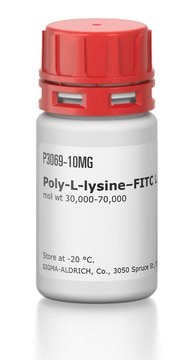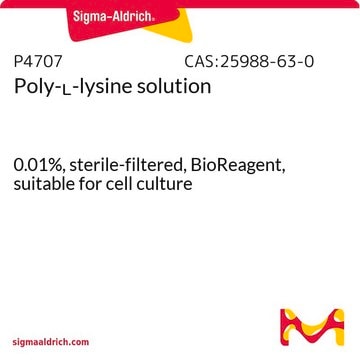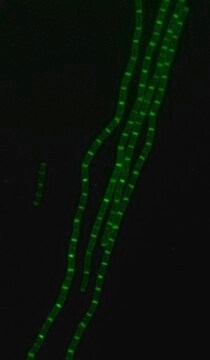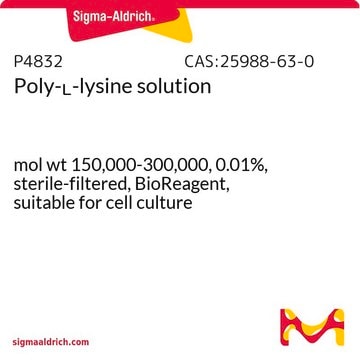The viscosity average molecular weight (Mv) is determined for each lot of this product. However, there is a distribution of molecular weights around that Mv. As a result, the molar concentration is not applicable. The typical degree of polymerization (DP) for this material is approximately 100 and the typical degree of substitution (moles of FITC per mole of lysine) is approximately 0.007 or 7 per 1000; essentially 7 of 10 Poly-L-Lysine molecules contain one FITC label. The concentration of the solution may be most accurately determined by precisely weighing the sample and precisely determining the volume, so that the sample may be reported as mg/mL. The degree of substitution and degree of polymerization are lot specific and reported in the product Certificate of Analysis. Please see the link below to review a sample of lot specific Certificate:
https://www.sigmaaldrich.com/product/sigma/p3543#product-documentation
P3543
Poly-L-lysine–FITC Labeled
mol wt 15,000-30,000
Synonym(s):
Fluorescein Labeled Poly-L-Lysine
Select a Size
About This Item
Recommended Products
form
powder
Quality Level
mol wt
precursor poly-L-lysine • HBr 15,000-30,000
15,000-30,000
extent of labeling
0.003-0.01 mol FITC per mol lysine monomer
color
yellow to orange
storage temp.
−20°C
Looking for similar products? Visit Product Comparison Guide
Related Categories
Other Notes
Storage Class Code
11 - Combustible Solids
WGK
WGK 3
Flash Point(F)
Not applicable
Flash Point(C)
Not applicable
Personal Protective Equipment
Choose from one of the most recent versions:
Certificates of Analysis (COA)
Don't see the Right Version?
If you require a particular version, you can look up a specific certificate by the Lot or Batch number.
Already Own This Product?
Find documentation for the products that you have recently purchased in the Document Library.
Customers Also Viewed
Articles
Humankind has utilized protein materials throughout its existence, starting with the use of materials such as wool and silk for warmth and protection from the elements and continuing with the use of recombinant DNA techniques to synthesize proteins with unique and useful properties.
-
ow do you determine the peptide concentration of a small scoop in solution? I am reading the absorbance at 495nm to read the fluorophore but I don't know how to convert that Absorbance value to a meaningful mg/mL or molarity concentration without an e.c.
1 answer-
Helpful?
-
-
How much FITC quantity or weight percentage is present per mg of the mixture? If 10 mg of the product is weighed out, what portion of the weight corresponds to the PLL?
1 answer-
The FITC quantity present per mg of the mixture is 0.016 mg, which corresponds to approximately 1.6% of the weight. If 10 mg of the product is weighed out, the portion of the weight corresponding to the PLL is approximately 9.84 mg.
Helpful?
-
Active Filters
Our team of scientists has experience in all areas of research including Life Science, Material Science, Chemical Synthesis, Chromatography, Analytical and many others.
Contact Technical Service









